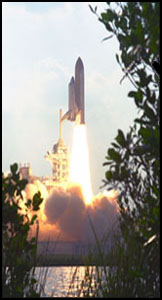 A shuttle launch is a well-practiced and well-engineered procedure, but it is hair raising nonetheless. The STS vehicle (two boosters, a fuel tank, and the orbiter itself) starts off bolted to the launch pad, leaning back a little bit under the weight of the Orbiter. At the end of the countdown, the Orbiter's main engines ignite. This causes the whole STS to rock forwards slightly. If the engine firing is successful, the solid rocket boosters are ignited - they can't be turned off once they are on! - and the tiedown bolts are released. The shuttle climbs off of the pad, and is largely out of the atmosphere 1 minute later.
A shuttle launch is a well-practiced and well-engineered procedure, but it is hair raising nonetheless. The STS vehicle (two boosters, a fuel tank, and the orbiter itself) starts off bolted to the launch pad, leaning back a little bit under the weight of the Orbiter. At the end of the countdown, the Orbiter's main engines ignite. This causes the whole STS to rock forwards slightly. If the engine firing is successful, the solid rocket boosters are ignited - they can't be turned off once they are on! - and the tiedown bolts are released. The shuttle climbs off of the pad, and is largely out of the atmosphere 1 minute later.
The launch puts 3 "G's" of force on the Shuttle and all of its contents; under this force, AMS's whole structure will bend downwards by a few centimeters. In addition, there are 150 decibels of noise, a really unbelieveable shaking that can easily twist off an unsecured bolt or two. (It's OK, AMS will have no unsecured bolts!) Meanwhile, we are rushing upwards at, eventually, ten kilometers per second.
After only one minute, AMS will be above most of the atmosphere - an important detail, since all of the air inside of AMS has to be able to escape quickly. (So, as much as we'd like to, we cannot wrap AMS in airtight, light-tight plastic - we have to leave big paths for the air to escape). After three minutes, the engines begin cutting out, the vibration ceases, and we're basically in orbit. From there on, the Shuttle gives AMS a smooth ride to the International Space Station.